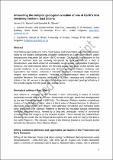Files in this item
Unravelling the complex geological evolution of one of Earth's final remaining frontiers : East Siberia
Item metadata
| dc.contributor.author | Barnet, James S.K. | |
| dc.contributor.author | Steiner, Benedikt M. | |
| dc.date.accessioned | 2022-01-26T00:39:12Z | |
| dc.date.available | 2022-01-26T00:39:12Z | |
| dc.date.issued | 2021-01-26 | |
| dc.identifier | 272661700 | |
| dc.identifier | 545a1f0a-634f-4617-8e46-fad6fcd0948b | |
| dc.identifier | 85099940848 | |
| dc.identifier.citation | Barnet , J S K & Steiner , B M 2021 , ' Unravelling the complex geological evolution of one of Earth's final remaining frontiers : East Siberia ' , Geology Today , vol. 37 , no. 1 , pp. 12-17 . https://doi.org/10.1111/gto.12336 | en |
| dc.identifier.issn | 0266-6979 | |
| dc.identifier.other | RIS: urn:53C6F8BCD3FEC3421A7AEBE42B40B7E6 | |
| dc.identifier.uri | https://hdl.handle.net/10023/24750 | |
| dc.description.abstract | East Siberia represents one of the most remote and inhospitable regions on the planet, home to the coldest permanently inhabited settlement on Earth (Oymyakon), where temperatures frequently fall below -50°C in winter. Geological investigations in this part of northern Asia are severely hampered by thick permafrost, a lack of infrastructure, vast tracts of barren uninhabited rough terrain, and political challenges. However, the rocks buried below the freezing tundra and taiga of this remote land provide evidence of an interesting and diverse geological history, including vast hypersaline salt basins, voluminous volcanic eruptions, Himalayan-style mountain ranges, and extensive swamps. Following a comprehensive study of publically available literature, the majority published in Russian language and challenging to obtain in the UK, we aim to decipher the diverse and complicated geological history of this remote region over the past 1650 Myr. | |
| dc.format.extent | 6 | |
| dc.format.extent | 2950035 | |
| dc.language.iso | eng | |
| dc.relation.ispartof | Geology Today | en |
| dc.subject | QE Geology | en |
| dc.subject | SDG 15 - Life on Land | en |
| dc.subject.lcc | QE | en |
| dc.title | Unravelling the complex geological evolution of one of Earth's final remaining frontiers : East Siberia | en |
| dc.type | Journal item | en |
| dc.contributor.institution | University of St Andrews. School of Earth & Environmental Sciences | en |
| dc.identifier.doi | 10.1111/gto.12336 | |
| dc.description.status | Peer reviewed | en |
| dc.date.embargoedUntil | 2022-01-26 |
This item appears in the following Collection(s)
Items in the St Andrews Research Repository are protected by copyright, with all rights reserved, unless otherwise indicated.

